#pikuni
Explore tagged Tumblr posts
Text
At Long Last, The American Buffalo Has Come Home
A conservation effort has returned bison to Blackfeet Nation tribal lands more than a century after the animal was nearly slaughtered to extinction.
— Photographs By Louise Johns | By Lailani Upham | Sunday July 09, 2023
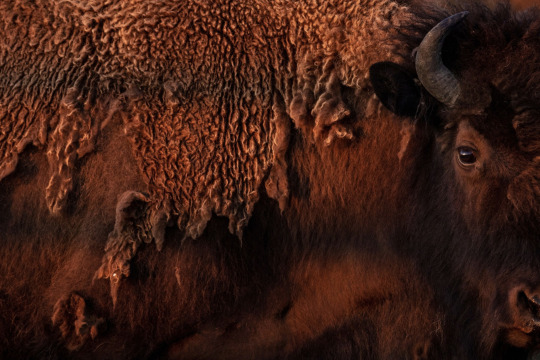
“Nititawahsi” is the Blackfeet name for our land—the land where the iinnii (buffalo) live. Our people are Niitawahsin-nanni: the people of the land where the iinnii live.
As colonizers moved west, millions of buffalo were killed and brought to the edge of extinction. Millions more Native peoples were murdered, displaced, and forced to assimilate. By the end of the 19th century, only 300 buffalo were left in the wild and Native populations dropped to less than 300,000.
Now, after more than 150 years, iinnii have finally returned to their homeland, the Amskapi Pikuni (Blackfeet Nation) tribal lands, to roam free.

Forty-nine buffalo run out of their temporary enclosure towards Chief Mountain on the Blackfeet Reservation. The rest of the herd (about 70 buffalo) will join them at the end of the summer. Chief Mountain is not only prime buffalo habitat, but also a sacred place for Native people in both the U.S. and Canada.
“I can’t hardly describe the feeling that I have. I have this jittery feeling, goosebumps,” says Ervin Carlson, director of the Blackfeet Nation Buffalo Program. “It just feels so good to finally see them here in this place where we want them to be.”
On June 26, 49 iinnii were released into the wild at the base of our sacred Ninaistako (Chief Mountain), a Strong Miistaaki (Mountain) that stands tall like the warbonnets of Blackfeet warriors. This miistaaki towers along the border of the Blackfeet Nation, Glacier National Park in Montana, and Waterton National Park in Canada.
Our people, the Siksikaitsitapi (Blackfoot Confederacy) always believed the land we came from was a gift of the Creator, Ihtsi-pai-tapi-yopa. Our stories tell us that iinnii was created as a gift for our people as our life source. The iinnii were and still are our staff of life.
The iinnii coming back and being free on Blackfoot lands again is the beginning of reconciliation, says Cristina Mormorunni, director of Indigenous Led, the organization that leads cultural restoration and conservation of buffalo on Blackfoot lands. “This is the beginning of the truth being told about what happened, and they’re the best ambassadors,” she says.


Helen Augare, a Blackfeet knowledge keeper and director of the Blackfeet Community College Native Science Field Center, has been an integral voice in the return of buffalo to Chief Mountain for the past 15 years.
Now that the buffalo are free, she says “there’s so much still to reconnect to and learn from them.”
“What does that future look like and what [do] our children and grandchildren need to know to be able to help iinnii live a full and prosperous life with us again?” Augare says. “It entailed everything from healthy people, healthy land, healthy water, and most of all healthy relationships. That in itself requires a lot of healing, growth.”

Buffalo are corralled and sorted (calves from adults, and males from females) at the tribal-owned Buffalo Spirit Hills Ranch on June 25, 2023. The herd, originally from Canada’s Elk Island National Park, have been living on the ranch since 2016. The herd descends from the last remaining wild buffalo before they were nearly extirpated.

Blackfeet tribal member Wyett Wippert takes a photo of his daughter, Ruby, in front of the buffalo in their soft release pen at Chief Mountain. “We put so much of our hearts into getting them here,” he says. “It’s a very good feeling knowing that they are under Chief Mountain. People know what they’re going to be doing for their environment and for us as Blackfeet people.” The buffalo are held here for several hours to settle into their surroundings before being released into the wild.
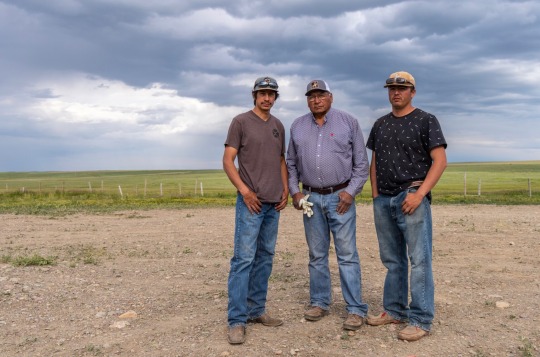
Racine, Monroe, and director Ervin Carlson of the Blackfeet Buffalo Program, on June 25, 2023, after a long day of preparing buffalo to be released at Chief Mountain. “It’s a lot of work to get these animals to this point… they are wild buffalo,” Racine says. “Nobody can do it by themselves. It’s a real honor to be able to have the Iinnii here and to be doing this.”
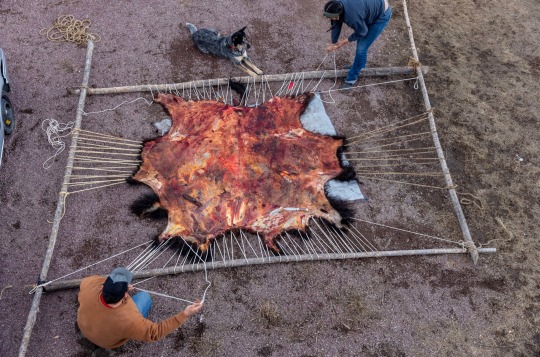
Blackfeet tribal members Wyett Wippert and Christen Falcon work together to stretch their bison hide onto their handmade wooden frame, the first step in tanning the hide by hand at their home in East Glacier, Montana. on April 9, 2023.

“Bison are a keystone species, they are ecosystem drivers and engineers. They were here for thousands of years,” says Brandon Kittson, wildlife biologist for Blackfeet Fish and Wildlife. “Now having them back on this landscape is a good thing. It’s going to help revitalize some systems and help drive diversity among the different vegetation and communities found in this area.”
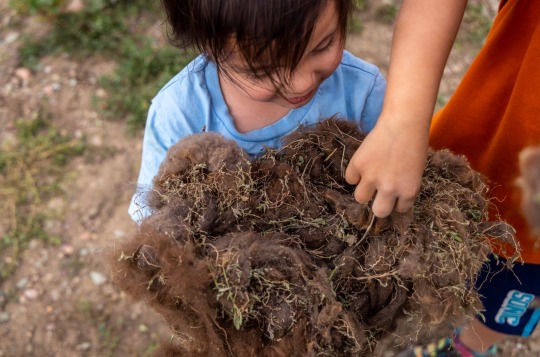
Children collect and examine clumps of buffalo fur from the corral at Buffalo Spirit Hills Ranch on June 25, 2023. The fur is integral to the health of the grassland ecosystem, as certain species of birds use it to line and insulate their nests.
— Photojournalist Louise Johns is a National Geographic Explorer. Her National Geographic Society-funded Project, "Buffalo Renaissance," is about Native American efforts to restore Bison to build cultural resiliency and ecological integrity.
#The National Geographic#American Buffalo#Photojournalist#Louise Johns#Buffalo Renaissance#Amskapi Pikuni (Blackfeet Nation)#Niitawahsin-Nanni#Chief Mountain#Ninaistako (Chief Mountain)#Glacier National Park in Montana#Waterton National Park in Canada#The Siksikaitsitapi (Blackfoot Confederacy)#Cristina Mormorunni#Helen Augare#Montana USA 🇺🇸#Canada 🇨🇦#Brandon Kittson Wildlife Biologist#National Geographic Explorer
32 notes
·
View notes
Note
hi! first of all: thank you for all your fc help, i have found so many amazing faces through you! id love to hear who are some faces youd love to see more that are early 30s to mid 40s, any gender, preferably a person of color! bonus points if they look a little stoic but could have a soft spot! thank you so much, i cant wait to look through who you are suggesting!
Kayvan Novak (1978) Iranian.
Ser Anzoategui (1979) Argentinian and Paraguayan - is non-binary (they/them) - has said that they're a person of colour!
Hend Sabry (1979) Egyptian.
Angelica Ross (1980) African-American - is trans.
Madeleine Sami (1980) Fijian-Indian / White - is a lesbian.
Amara Zaragoza / Tamara Feldman (1980) Shawnee, Mexican [Purépecha], White - has Multiple Sclerosis.
Tahar Rahim (1981) Algerian.
Jesse Williams (1981) African-American, Seminole / Swedish.
Amanda Seales (1981) African-American / Grenadian [African, at least one quarter European].
Rajshri Deshpande (1982) Indian.
Riz Ahmed (1982) Pakistani.
Yolanda Bonnell (1982) Ojibwe, White / Indian - is two-spirit and queer (she/they) - is open about having OCD and ADHD!
Luna Maya (1983) Indonesian.
Aaradhna (1983) Samoan / Gujarati Indian.
Amir Eid (1983) Egyptian.
Kid Cudi (1984) African-American.
Firass Dirani (1984) Lebanese.
Mohamed Emam (1984) Egyptian.
Mahira Khan (1984) Pakistani.
Sami Zayn (1984) Syrian.
Zawe Ashton (1984) Ugandan / White.
Ravyn Ariah Wngz (1984) Mohawk, Tanzanian, Afro-Bermudian - is a Two-Spirit trans woman (she/her).
Kristin Chirico (1984) - is questioning their gender, “encompassing a lot of things” but is not yet sure if she’s nonbinary or a gender non-confirming woman and uses they/her - openly bisexual and demisexual and have Obsessive Compulsive Disorder, ADHD, dyslexia, and asthma.
Troian Bellisario (1985) American, Louisiana Creole [African, French, English] / White.
Lilan Bowden (1985) Taiwanese / White.
Sepideh Moafi (1985) Iranian.
Alex Meraz (1985) Mexican [Purépecha].
a gap because tumblr hates large chunks of text!
Aabria Iyengar (1985) African-American.
Rahul Kohli (1985) Punjabi Indian - uses he/they.
Sonam Kapoor (1985) Punjabi and Sindhi Indian.
T'Nia Miller (1985) Afro Jamaican - is a lesbian.
Karim Kassem (1986) Egyptian / Egyptian Jewish.
Che Jim (1989) Navajo, Odawa, Nahua.
Mihaela Drăgan (1986) Romani - is queer.
Jodi Balfour (1986) - is queer.
Chai Fonacier (1986) Bisaya Filipino.
Diane Guerrero (1986) Colombian - has called herself a woman of colour!
Lido Pimienta (1986) Colombian [Wayuu, Afro-Colombian] - is queer.
Charlyne Yi (1986) Korean, Yuki, Mexican, Filipina, Spanish, French, Irish, and German - is non-binary and queer (they/them).
Alba Flores (1986) Romani and Spanish - is a lesbian.
Saagar Shaikh (1986) Pakistani.
Mustafa Ali (1986) Pakistani.
Lily Gladstone (1986) Kainai Blackfoot, Amskapi Pikuni Blackfoot, Nez Perce, Dutch, Cajun - she/they.
Marwa Agrebi (1987) Tunisian.
Susan Wokoma (1987) Nigerian.
Munroe Bergdorf (1987) Afro Jamaican / English - is a trans woman.
Juliana Huxtable (1987) African-American - is a trans woman.
Anjana Vasan (1987) Tamil Indian.
Pearl Mackie (1987) West Indian / English - is bisexual.
Erika Ishii (1987) Japanese - is genderfluid (she/they/any).
Kendrick Sampson (1988) African-American / White.
Aiysha Hart (1988) Saudi Arabian and English.
a gap because tumblr hates large chunks of text!
Joel Kim Booster (1988) Korean - is gay and has bipolar disorder.
Gratiela Brancusi (1989) Romani and Greek Romanian.
Frank Waln (1989) Sicangu Oyate Lakota Sioux.
Mishel Prada (1989) Puerto Rican, Dominican Republic, and Mexican [Spanish, Portuguese, African, Indigenous], some French.
Rakeen Saad (1989) Jordanian.
Victoria Monét (1989) French, African-American/Creole - is bisexual.
Meyne Wyatt (1989) Wongutha and Yamatji.
Dina Torkia (1989) Egyptian / White.
Quinta Brunson (1989) African-American.
Kiell Smith-Bynoe (1989) Afro Barbadian and Afro Jamaican - donated an auction to Cinema4Gaza.
Laith Ashley (1989) Afro Dominican - is a trans man and asexual.
Mitski (1990) Japanese / White.
Arrows Fitz (1990) African-American - is non-binary (he/they/she/it).
Shirine Boutella (1990) Algerian.
Paapa Essiedu (1990) Ghanaian.
Lolly Adefope (1990) Yoruba Nigerian.
Anjli Mohindra (1990) Punjabi.
Tabria Majors (1990) African-American.
Rosaline Elbay (1990) Egyptian.
Justin H. Min (1990) Korean.
Bowen Yang (1990) Chinese - is gay.
Amir El-Masry (1990) Egyptian.
Katie Findlay (1990) English, Hongkonger, Portuguese-Macanese, Scottish - is queer (they/them).
Poppy Liu (1990) Chinese - is non-binary (she/they).
Shareena Clanton (1990) Blackfoot, Cherokee, African-American, Wangkatha, Yamatji, Noongar, Gija.
Nayuka Gorrie (1990) Gunai, Gunditjmara, Wiradjuri, Yorta Yorta, Scottish - is non-binary (they/them).
Jes Tom (1990) Japanese / Chinese - is a trans guy (they/he/she) - has no gifs from after he came out as a trans guy1
Kiowa Gordon (1990) Hualapai and White.
Zahraa Ghandour (1991) Iraqi.
Alok Vaid-Menon (1991) Malayali and Punjabi Indian - is gender-nonconforming, non-binary transfeminine (they).
Jari Jones (1991) African-American / Filipino - is trans.
Denée Benton (1991) African-American.
Ellora Torchia (1992) Pakistani / White.
Pınar Deniz (1993) Turkish [Lebanese].
Ramy Youssef (1991) Egyptian.
Sarah Kameela Impey (1991) Indo-Guyanese / White.
Jamael Westman (1991) Afro Jamaican / White.
Anna Shaffer (1992) Black and White / Jewish.
Vinnie Bennett (1992) Kāi Tahu, Ngāti Porou, Ngā Puhi, White.
Paloma Elsesser (1992) African-American / Chilean-Swiss.
Rivkah Reyes (1992) Filipinx-Jewish - uses they/she but mostly they.
Medalion Rahimi (1992) Iranian, Iranian Jewish - uses she/they.
Rose Matafeo (1992) Samoan / Scottish and Croatian.
Zaqi Ismail (1992) Tanzanian.
Madeleine Sami (1980) Fijian-Indian / White - is a lesbian.
Amara Zaragoza / Tamara Feldman (1980) Shawnee, Mexican [Purépecha], White - has Multiple Sclerosis.
Tahar Rahim (1981) Algerian.
Jesse Williams (1981) African-American, Seminole / Swedish.
Amanda Seales (1981) African-American / Grenadian [African, at least one quarter European].
Rajshri Deshpande (1982) Indian.
Riz Ahmed (1982) Pakistani.
Yolanda Bonnell (1982) Ojibwe, White / Indian - is two-spirit and queer (she/they) - is open about having OCD and ADHD!
Luna Maya (1983) Indonesian.
Aaradhna (1983) Samoan / Gujarati Indian.
Amir Eid (1983) Egyptian.
Kid Cudi (1984) African-American.
Firass Dirani (1984) Lebanese.
Mohamed Emam (1984) Egyptian.
Mahira Khan (1984) Pakistani.
Sami Zayn (1984) Syrian.
Zawe Ashton (1984) Ugandan / White.
Ravyn Ariah Wngz (1984) Mohawk, Tanzanian, Afro-Bermudian - is a Two-Spirit trans woman (she/her).
Kristin Chirico (1984) - is questioning their gender, “encompassing a lot of things” but is not yet sure if she’s nonbinary or a gender non-confirming woman and uses they/her - openly bisexual and demisexual and have Obsessive Compulsive Disorder, ADHD, dyslexia, and asthma.
Troian Bellisario (1985) American, Louisiana Creole [African, French, English] / White.
Lilan Bowden (1985) Taiwanese / White.
Sepideh Moafi (1985) Iranian.
Alex Meraz (1985) Mexican [Purépecha].
Aabria Iyengar (1985) African-American.
Rahul Kohli (1985) Punjabi Indian - uses he/they.
Sonam Kapoor (1985) Punjabi and Sindhi Indian.
T'Nia Miller (1985) Afro Jamaican - is a lesbian.
Karim Kassem (1986) Egyptian / Egyptian Jewish.
Che Jim (1989) Navajo, Odawa, Nahua.
Mihaela Drăgan (1986) Romani - is queer.
Jodi Balfour (1986) - is queer.
Chai Fonacier (1986) Bisaya Filipino.
a gap because tumblr hates large chunks of text!
Diane Guerrero (1986) Colombian - has called herself a woman of colour!
Lido Pimienta (1986) Colombian [Wayuu, Afro-Colombian] - is queer.
Charlyne Yi (1986) Korean, Yuki, Mexican, Filipina, Spanish, French, Irish, and German - is non-binary and queer (they/them).
Alba Flores (1986) Romani and Spanish - is a lesbian.
Saagar Shaikh (1986) Pakistani.
Mustafa Ali (1986) Pakistani.
Lily Gladstone (1986) Kainai Blackfoot, Amskapi Pikuni Blackfoot, Nez Perce, Dutch, Cajun - she/they.
Marwa Agrebi (1987) Tunisian.
Susan Wokoma (1987) Nigerian.
Munroe Bergdorf (1987) Afro Jamaican / English - is a trans woman.
Juliana Huxtable (1987) African-American - is a trans woman.
Anjana Vasan (1987) Tamil Indian.
Pearl Mackie (1987) West Indian / English - is bisexual.
Erika Ishii (1987) Japanese - is genderfluid (she/they/any).
Kendrick Sampson (1988) African-American / White.
Aiysha Hart (1988) Saudi Arabian and English.
Joel Kim Booster (1988) Korean - is gay and has bipolar disorder.
Gratiela Brancusi (1989) Romani and Greek Romanian.
Frank Waln (1989) Sicangu Oyate Lakota Sioux.
Mishel Prada (1989) Puerto Rican, Dominican Republic, and Mexican [Spanish, Portuguese, African, Indigenous], some French.
Rakeen Saad (1989) Jordanian.
Victoria Monét (1989) French, African-American/Creole - is bisexual.
Meyne Wyatt (1989) Wongutha and Yamatji.
Dina Torkia (1989) Egyptian / White.
Quinta Brunson (1989) African-American.
Kiell Smith-Bynoe (1989) Afro Barbadian and Afro Jamaican - donated an auction to Cinema4Gaza.
Laith Ashley (1989) Afro Dominican - is a trans man and asexual.
Mitski (1990) Japanese / White.
Arrows Fitz (1990) African-American - is non-binary (he/they/she/it).
Shirine Boutella (1990) Algerian.
Paapa Essiedu (1990) Ghanaian.
Lolly Adefope (1990) Yoruba Nigerian.
Anjli Mohindra (1990) Punjabi.
Tabria Majors (1990) African-American.
Rosaline Elbay (1990) Egyptian.
Justin H. Min (1990) Korean.
Bowen Yang (1990) Chinese - is gay.
Amir El-Masry (1990) Egyptian.
Katie Findlay (1990) English, Hongkonger, Portuguese-Macanese, Scottish - is queer (they/them).
Poppy Liu (1990) Chinese - is non-binary (she/they).
Shareena Clanton (1990) Blackfoot, Cherokee, African-American, Wangkatha, Yamatji, Noongar, Gija.
Nayuka Gorrie (1990) Gunai, Gunditjmara, Wiradjuri, Yorta Yorta, Scottish - is non-binary (they/them).
Jes Tom (1990) Japanese / Chinese - is a trans guy (they/he/she) - has no gifs from after he came out as a trans guy!
Kiowa Gordon (1990) Hualapai and White.
Zahraa Ghandour (1991) Iraqi.
Alok Vaid-Menon (1991) Malayali and Punjabi Indian - is gender-nonconforming, non-binary transfeminine (they).
Jari Jones (1991) African-American / Filipino - is trans.
Denée Benton (1991) African-American.
Ellora Torchia (1992) Pakistani / White.
Pınar Deniz (1993) Turkish [Lebanese].
Ramy Youssef (1991) Egyptian.
Sarah Kameela Impey (1991) Indo-Guyanese / White.
Jamael Westman (1991) Afro Jamaican / White.
Anna Shaffer (1992) Black and White / Jewish.
Vinnie Bennett (1992) Kāi Tahu, Ngāti Porou, Ngā Puhi, White.
Paloma Elsesser (1992) African-American / Chilean-Swiss.
Rivkah Reyes (1992) Filipinx-Jewish - uses they/she but mostly they.
Medalion Rahimi (1992) Iranian, Iranian Jewish - uses she/they.
Rose Matafeo (1992) Samoan / Scottish and Croatian.
Zaqi Ismail (1992) Tanzanian.
Oooo this is such a lovely message, thank you so much anon! I've honestly found so many amazing actors and artists through people speaking up about Palestine so all of these have, those with resources at the time of posting are bolded! 💌
9 notes
·
View notes
Note
ive been looking for other siksikaitsitapi forever!! are you pikuni too?
me too!! but i’m not pikuni, i’m kainai
3 notes
·
View notes
Text

Pikuni gathering. Chief Eagle Child; Chief Two Guns White Calf; Medicine Owl; Curly Bear; Big Spring; Bird Plume; Wolf Plume; Bird Rattler; Bill Schute; Stabs By Mistake; Mad Plume; Many Tail Feathers. Mary Roberts Rinehart was adopted by the Blackfeet tribe and given the name Pitamakan (Running Eagle). Mary wrote about this trip in her 1917 book, Through Glacier Park.
2 notes
·
View notes
Text


Canada’s first national park
In 1871, AS A CONDITION OF BRITISH COLUMBIA JOINING Canada, the Canadian Government had to agree to build a transcontinental railroad linking BC to the rest of the country. Of course, the construction of a transcontinental railroad also established a claim to the remaining parts of British North America not yet integrated into either the Canadian or America nation-states. It comes as no surprise that Banff National Park was created in 1885, the year of the defeat of the Metis Rebellion, which cleared and opened the west for settlement, tourists and capital investment.
The official story goes that in 1882, Tom Wilson, a surveyor for the Canadian Pacific Railway, “discovered” Lake Louise, the most accessible centerpiece of the park, on the way through the Rockies. A year later the Cave and Basin Hot springs were discovered by three railway construction workers. People began to flock to the site, hotels went up and the town of Banff was born.
The truth, however, is that it was people from the Nakodah First Nation that guided Wilson to the Lake. In fact, they already had a name for it, they called it “The Lake of the Little Fish.” The Nakodah (also known as Stoney) are descendants of the Dakota and Lakota nations of the Great Plains and the Rocky Mountains, part of the large Sioux Nation.
The name “Stoney” was given them by white explorers because of their technique of using fire-heated rocks to boil broth in rawhide bowls. The Nakodah were familiar with the area, having lived throughout it for at least several hundred years. They knew the trails and passes as part of their hunting grounds. There is archaeological evidence pointing to human occupation going back at least ten thousand years, but apparently the Nakodah came from somewhere around the Mississippi after an outbreak of smallpox in the 1600’s.
In any case, by the time the Railroad was being built, the mountains were part of their home. I’m not aware of any uprisings to protect their homelands, however the “Stoney” were signatories to Treaty 7. (In order for the transcontinental railroad to make its way across Canada, it had to go through what were recognized as the traditional lands of different aboriginal peoples. So it was important for the Canadian State to negotiate Treaties with the distinct tribes living along the route to allow the railroad to be built.) Regardless, the whole territory was evidence of long term harmonious human occupation, much like Yellowstone.
Sadly, during the first decades, park managers would do regular predator hunts, believing that mountain lions, coyotes and wolves, for instance, should be killed to save deer and elk. And now, only a hundred and thirty years later, many of the Park’s eco-systems are threatened, as are several of the animals who live within it, and the Nakodah live on a reservation.
In its 2007 annual report the Parks Canada web site states: “Parks Canada continued to work with the Siksika Nation and Indian and Northern Affairs Canada to resolve the outstanding specific claim in the park.” The claim is by the Siksika First Nation. Furthermore, in May 2000 the Siksika threatened “ to occupy Castle Mountain in Banff National Park to pressure the federal government into handing it over. The Siksika, who live east of Calgary near Gleichen, say they’ve been trying since 1960 to gain control of a 68-square-kilometre parcel that was used by their ancestors for rituals.[4]”
The Siksika are part of the Blackfoot Confederacy, which consists of four different tribes, the Pikuni/Peigan, North Peigan Pikuni, Blood/Kainai, and Blackfoot/Siksika. Banff is the most heavily developed national park in North America, entertaining more than five million visitors a year and has been the site of fights between environmentalists and developers. Environmentalists claim that added development “will put added stress on a fragile lake region where grizzly bears, lynx and wolverines are already threatened by the presence of as many as 20,000 tourists a day.[5]”
#canada#national parks#canadian national parks#freedom#ecology#climate crisis#anarchism#resistance#community building#practical anarchy#practical anarchism#anarchist society#practical#revolution#daily posts#communism#anti capitalist#anti capitalism#late stage capitalism#organization#grassroots#grass roots#anarchists#libraries#leftism#social issues#economy#economics#climate change#climate
0 notes
Photo

«¿Qué es la vida? Es el destello de una luciérnaga en la noche. Es el aliento de un búfalo en invierno. Es la pequeña sombra que corre a través de la hierba y se pierde en la puesta de sol.» Proverbio Pies Negros. Campamento Piegan. Fotografía realizada por Edward S. Curtis. Año 1900. Los Piegan o Pikuni son una de las tribus de la gran Confederación de los Pies Negros.
#blackfootindian#blackfoot tribe#blackfeet nation#blackfoot#blackfeet#natives#native#native american#Native America#Nativo#nativos#nativo americano#nativoamerica#Nativos Americanos#american indian
1 note
·
View note
Link
0 notes
Text
Throwing my own bookshelf into the notes! I know I have more than these, but probably in a box somewhere from the last time I moved...
Children's Ancestor Approved: Intertribal Stories for Kids, edited by Cynthia Leitich Smith The Used-To-Be-Best-Friend and Fancy Pants from the JoJo Makoons series, Dawn Quigley Thunderous, M.L Smoker & Natalie Peeterse
Fiction The Lost Journals of Sacajawea, Debra Magpie Earling The Stories We Tell, the Whitefish Review The Sentence, Louise Erdrich PermaRed, Debra Magpie Earling Black Sun, Rebecca Roanhorse
Non-Fiction People Before the Park, Sally Thompson, Kootenai Culture Committee & Pikuni Traditional Association The Homefullness Handbook, Poor Family Magazine The World We Used To Live In, Vine Deloria Jr Braiding Sweetgrass, Robin Wall Kimmerer
Poetry Horsefly Dress, Heather Calhoun When the Light of the World Was Subdued, Our Songs Came Through, edited by Joy Harjo Descended from a Travel-Worn Satchel, Chris La Tray One Sentence Journal, Chris La Tray
What I'm Reading Right Now: The Lost Journals of Sacajawea by Debra Magpie Earling
For usamericans who may not know how to support decolonization and indigenous people in their every-day lives, may I suggest checking this list of native-owned businesses, curated and maintained by indigenous folks. There's food, candles, cbd pre-rolls, clothes, jewelry, hats, baby things, handicrafts, art, and hundreds of other useful and wonderful things. I check this list before I buy non-native owned as often as I can.
Also check out the native-owned (pulitzer-prize winner Louise Erdrich started it!) bookstore and press Milkweed Editions (dot org) for an amazing selection of books by indigenous authors. I recommend Braiding Sweetgrass by Robin Wall Kimmerer (a collection of essays that will change your thinking if your mind is open at all) that's great for sitting down to read for bite-sized chunks. For book recommendations, check out this infographic!
Do you own property and want to support landback but still need a place to live? Odds are good that there's established precedence in your area to transfer its jurisduction to a local tribe and pay your land taxes and etc to them instead of the settler government!
Here is a list of charities and fundraisers for indigenous support.
Other ways to educate yourself and learn what indigenous people are working on nationally and locally is to follow indigenous people online! Many Native peoples on various social medias tag with #indigenous, #native, and by looking at those you will find many other tags and people to follow.
If you have extra cash, consider paying indigenous people's bail, donating to some of the causes linked above, or look for local initiatives to support in your own community!
5K notes
·
View notes
Photo


Dress
Pikuni Blackfeet (Piegan) People
c.1850
National Museum of the American Indian (Catalog Number: 10/8454)
Learn more about the Pikuni Blackfeet at their website: https://blackfeetnation.com/
#dress#fashion history#native american#indigenous americans#pikuni blackfeet#blackfeet#1850s#19th century#piegan#1850#leather#beading#traditional fashion#traditional clothing#national museum of the american indian
271 notes
·
View notes
Text
Canceled Tribal Chief White Calf, Face of The Redskins, Generates New Support Nationwide
— Kerry Byrne | Tuesday February 6, 2024

Chief John Two Guns White Calf, left, served as the inspiration for the Washington Redskins logo, right — which represented the NFL franchise on the field for nearly 50 years, from 1972 to 2020.
"The Redskins were the only minority representation in the entire NFL and it was a real person, not a mascot," historian Andre Billeaudeaux of San Diego, California, the author of "How the Redskins Got Their Name," told Fox News Digital in an interview.
The NCAI counts among its benefactors the George Soros-funded Open Society Foundations. American taxpayers also fund the group.
It receives support from seven federal bureaucracies, including the Department of Defense, according to its own website, as Fox News Digital previously reported.
Beyond the removal of Native logos and representations in pro sports, the NCAI "has tracked the retirement of more than 200 unsanctioned Native ‘themed’ mascots since 2019, and has supported legislation banning the use of these mascots in multiple states," the group said in a statement last year to Fox News Digital.
Yet "these decisions never have popular support," said Eunice Davidson, a Dakota Sioux and president of the Native American Guardians Association (NAGA), to Fox News Digital last week.
Many of those images were founded up to a century ago to celebrate local Native heritage — and not all were mascots.

Top: Left, Native American Blackfeet Chief John Two Guns White Calf (1872-1934), is shown shaking hands with A. Aaron of Madras, India, as they met at the Twin Cities for the Rotary Convention, circa 1925. Bottom: Blackfeet dressed in full ceremonial traditional clothing, Browning, Montana, U.S., circa 1930.
Some — like the man who was the face of the Redskins — were real people who made a profound impact on America.
Even before his face was beamed from NFL football fields into millions of American homes each Sunday in the fall, Chief White Calf's name and image were familiar to people all across the United States and elsewhere.
"He provides one of the most readily recognizable images of a Native American in the world," the Native American Heritage Project website reported in 2012.
He was born near Fort Benton, Montana, in 1872, the site states. He was the son of White Calf, chief of the Pikuni Blackfoot.
He achieved international acclaim by fighting to preserve Native American culture.
"The chief headed a secret group known as the ‘Mad Dog Society’ whose purpose was to protect and sustain the Blackfoot Heritage," according to the Kansas City Public Library.
"The Crazy Dog Society Song," from an album of Blackfoot music, is held in the Smithsonian Institution's collection of Folkways recordings.
The Kansas City Public Library added, "Chief Two Guns was very outspoken about U.S. policies and the mistreatment of Native Americans."
He championed Native issues in Washington, D.C. — rubbing elbows with President Calvin Coolidge — and appeared to bridge cultures long at odds.
White Calf was, according to multiple sources, the inspiration for the face that appeared on the U.S. Mint's famous 1913 Indian head nickel.
This account of the story is disputed, but the image on the coin bears a striking resemblance to known portraits of White Calf.
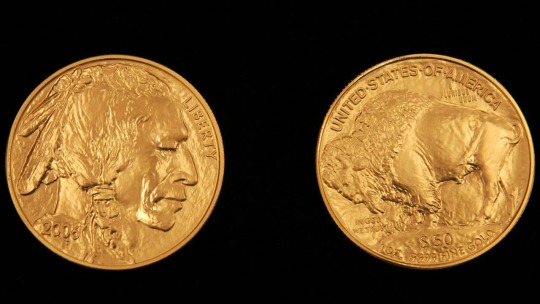
The two sides of the first 24-karat pure gold coin one-ounce replica of the U.S. Mint's Buffalo Nickel of 1913. Blackfeet chief John Two Guns White Calf is reportedly the inspiration for the Native American portrait found on the coin. His portrait later served as the face of the NFL's Washington Redskins from 1972 to 2020.
White Calf became a spokesman for Glacier National Park in Montana, "where he posed with tourists," according to the Native American Heritage Project and other accounts.
White Calf was so prominent in the United States that his death in 1934 earned a New York Times obituary.
The tribute noted that he helped make President Coolidge "an honorary chief of the same Blackfeet tribe."
The Redskins of the National Football League were founded as the Boston Braves in 1932, playing on the same field as the Boston Braves of baseball's National League.
In the tradition of the era, the upstart professional football team adopted the name, image and color scheme of the more established Major League Baseball team.
The National League Braves were represented by the image of Lenni Lenape chief Tammany, dubbed "the patron saint of America" for his role inspiring colonial troops in the American Revolution.

Left: Blackfeet chief John Two Guns White Calf. Right: Lenni Lenape chief Tammaned, also known as Tammany, was dubbed the "Patron Saint of America" by the generation that fought for American independence. This is an idealized portrait by Fritz Bade from descriptions of the man, as it appeared in the 1938 book, "The Tammany Legend" by Joseph White Norwood.
The Boston Football Braves found a new hometown field at Fenway Park, home of the Boston Red Sox, in 1933. The franchise changed its name to the Boston Redskins as a tribute to their hosts and to maintain their Tammany identity and uniforms.
The franchise then moved to Washington, D.C., in 1937 and for decades maintained its original indigenous identity.
In the 1970s, the Washington Redskins looked for a new Native American icon to represent the team. The image of White Calf was championed by Blackfeet tribal leader Walter "Blackie" Wetzel.
The Redskins stepped onto the field with a portrait of Chief White Calf on team helmets for the first time in 1972.
The similarities between White Calf and the face on the logo are unmistakable. The black-tipped white feathers and braided hair hanging down over the ear are also similar to those found in pictures of White Calf and other Blackfeet.
The proud, prominent face of White Calf enjoyed widespread support and input from Native communities across the country. Even the NCAI, for a time, appeared to be among those who favored the indigenous icon.
Wetzel, after all, was president of the NCAI from 1961 to 1964, before the organization changed its priorities.
But times have changed, noted Billeaudeaux.
While White Calf once fought against Washington, D.C., to preserve the heritage of American Indians, said Billeaudeaux — the NCAI now fights in Washington, D.C., to erase the heritage of American Indians.
The newer woke NCAI elevated its assault on Native American images in 2013, when it published a report dramatically called "Ending the Legacy of Racism in Sports & The Era of Harmful ‘Indian’ Sports Mascots."
The 29-page dissertation included a caustic 3,560-word history of the Redskins and its "legacy of racism."
Yet the NCAI Redskins' narrative is missing one notable name. It fails to mention Chief Two Guns White Calf — the face of the Redskins franchise for 48 years.

Top: Babe Ruth is shown signing autographs for fans while playing his last season for the Boston Braves. The National League Braves were founded by James Gaffney, a member of Tammany Hall, who adopted the image of Lenni Lenape chief King Tammany as the team logo, seen on Ruth's left sleeve. The Washington Redskins were founded in 1932 as the Boston Braves and adopted the same Tammany imagery.
Bottom: Donald Wetzel holds an autographed Washington Redskins football on June 27, 2014, in Great Falls, Montana. Wetzel, a member of the Blackfeet nation, was proud of the Washington Redskins logo that his father Walter designed in the 1960s and the team adopted in 1972.
Fox News Digital made several attempts to ask the NCAI to explain the oversight and to share its viewpoints — most recently on Monday, Feb. 5 — but did not receive a response.
The failure to mention the once-revered face of the Redskins franchise, in a history of the Redskins franchise, betrays the group's mission to promote a woke agenda over Native American heritage, Billeaudeaux charged.
The report even cites historical events of 1932, including a Tom & Jerry radio cartoon, to offer conflated support of its claims that the Redskins name was racist. Yet the NCAI failed to note that the team changed its name to the Redskins only after moving to Fenway Park, home of the Red Sox.
The study also did not mention Tammany, the original inspiration for the Braves/Redskins Native American imagery when the franchise was founded in 1932.
The NCAI report also argued, in a widely repeated claim, that indigenous mascots on sports teams have led to low self-esteem among Native Americans.
A source document cited in the claim was a brief study of 71 Native American children in Arizona in 2004.
But the claim that Native imagery creates low self-esteem is "a bald-faced lie," Walter "Red Hawk" Brown, chief of the Cheroenhaka Nottoway tribe of Virginia, told Fox News Digital.
The U.S. Army veteran said he was a fan of the Redskins until its history was erased. He added, "You take away self-esteem when you take away someone’s history."
He also said, "If things keep going the way they're going now, in 100 years there will be nothing left of our history."
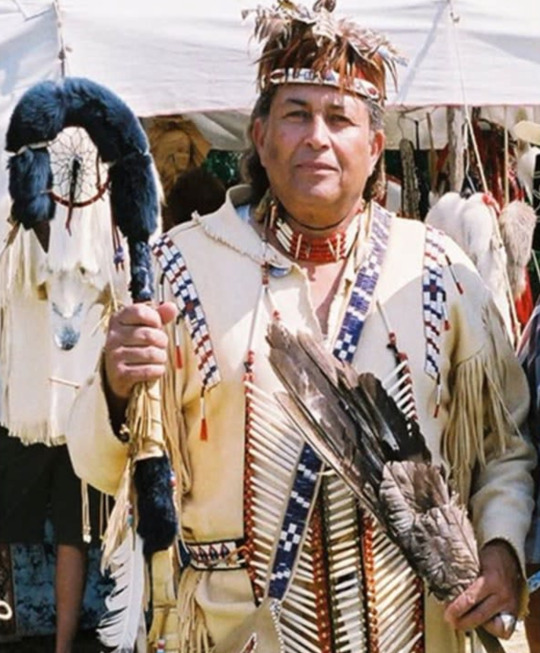
Walter "Red Hawk" Brown, chief of the Cheroenhaka Nottoway tribe of Virginia, refuted claims by the National Congress of American Indians that Native American logos in sports harm the self-esteem of those in Native American communities. Brown spent 28 years as a U.S. Army officer.
Redskins historian Billeaudeaux called the NCAI's version of events a "misinformation campaign" and "information laundering."
The NCAI tacitly admitted in its own report that White Calf's omission was not a mistake.
"Mr. Wetzel was not president of NCAI at the time he took these reported actions and these actions were not taken on behalf of NCAI’s members," the organization claimed, connecting Wetzel with the Redskins portrait but failing to name the man it portrayed.
The NCAI's incomplete history had the intended effect. The accusations of racism against the Redskins organization caught the attention of congressional leaders and President Obama — and stoked public outrage

The 42nd New York Volunteer Infantry Regiment was commonly known as The Tammany Regiment, in honor of the Lenni Lenape native who helped inspire the birth of the new nation. Tammany's image adorns a battlefield monument dedicated to the 42nd New York Volunteers at Gettysburg.
The Redskins erased the image of White Calf from the NFL seven years after the NCAI erased him from Native American history.
White Calf was not only scrubbed from the NCAI's 2013 history of the Redskins, but multiple searches on the organization's website also produced no mention of him.
"The whole thing has been a sham since the beginning," said NAGA president Davidson, expressing her viewpoint. "They don’t put out accurate information because they don’t want people to know the real story."
As recently as 2016, a poll by The Washington Post revealed that 90% of Native Americans supported the Redskins name and logo.
Over the past few years, communities across the nation have been stepping up to save their Chief White Calf Redskins heritage and other Native American images targeted by cancel culture and its woke proponents.
"They're trying to erase or eradicate Native American history," said Rick Spiegel, an activist in Sandusky, Michigan, who is leading a grassroots effort to reclaim the Redskins nickname and its White Calf portrait logo at the local high school.
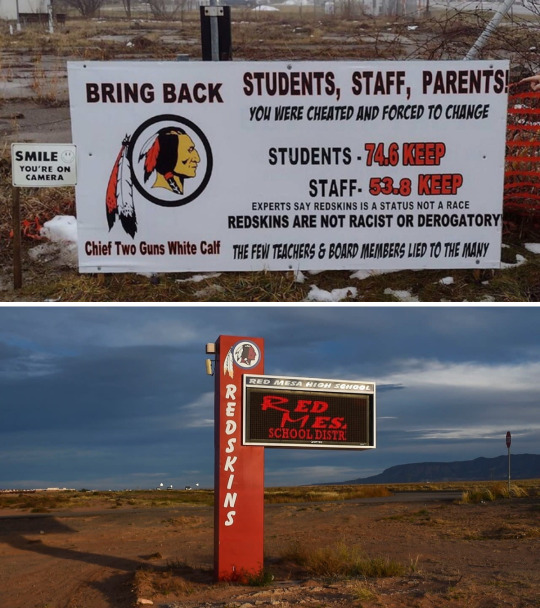
Top: Residents of Sandusky, Michigan, were angry that the local high school was forced to erase its Redskins identity despite popular support. The Redskins image is not a stereotype or mascot, noted local activist Rick Spiegel, but the portrait of celebrated Blackfeet Chief John Two Guns White Calf.
Bottom: The digital display sign bearing the Redskins logo is seen outside Red Mesa High School on Oct. 15, 2014, in Red Mesa, Arizona.
Voters in Sandusky recently recalled three school board members who voted to eliminate the Redskins. They've since elected three new pro-Native American school board members who campaigned to bring the Redskins back to Sandusky High School.
Spiegel said that nearly 90% of registered voters in the town who responded to a mail-in survey (1,900 of 2,100) supported the traditional Redskins — as did 74% of students and 53% of teachers at the school in another survey.
Despite overwhelming public support for the Redskins, Sandusky teams are now called the Wolves.
High schools around the nation with Native-majority student populations have displayed recent public support for their White Calf-portrait Redskins.
The Red Mesa (Arizona) High School Redskins installed a new football field last year with their White Calf Redskins logo splashed across the 50-yard line.
And students at Wellpinit (Washington) High School voted to keep the school's Redskins mascot in March 2023, rejecting efforts to erase it.
"It’s a very powerful word for us," student Smokey Abrahamson told the Spokesman-Review last March, after leading the Welpinit Redskins boys basketball team to a state championship.

Red Mesa football player Kai Lameman mounted on a mustang horse cheers as he leads his Redskins football team during the homecoming parade at Red Mesa High School on Oct. 16, 2014, in Red Mesa, Arizona. Red Mesa is a small Navajo school in northeast Arizona.
Students also "proudly chanted ‘Redskins power’" at a parade to honor the championship team, the Spokesman-Review reported.
"The people that I’ve talked to — they have a sense of pride about our name, and about our mascot being the Redskins," Taylor Wiebener, athletic director at Native-majority Kingston (Oklahoma) High School, told KXII.com in 2020.
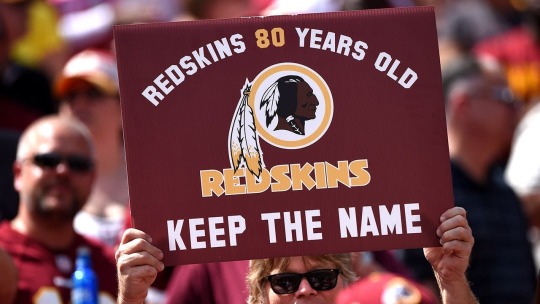
A Washington Redskins fan holds up a sign to keep the Redskins name before the team played the Jacksonville Jaguars at FedExField on Sept. 14, 2014, in Landover, Maryland.
And, according to activist and historian Billeaudeaux, students and residents of Donna, Texas, and McCloud, Oklahoma, also have repeatedly voiced support for their Redskins identity.
0 notes
Note
Hi there! I am hoping you are well and I am glad you are finding joy in 1x1 and discord again! Would you be able to help me with some fcs that could play cowboys/cowgirls/cowboys(but gnc idk what else to call them) whenever you have time? thank you! 💜🍉
Non-binary:
Ser Anzoategui (1979) Argentinian and Paraguayan - is non-binary (they/them).
Ally Beardsley (1988) - is non-binary (they/them).
Eliot Sumner (1990) - non-binary - they/them - lost smell was lost after a brain injury.
Vico Ortiz (1991) Puerto Rican - non-binary and genderfluid - they/them.
E.R. Fightmaster (1992) - non-binary (they/them).
Naomi McPherson (1993) Black and White - (they/them).
Chella Man (1998) Hongkonger, Jewish - is deaf - non-binary, genderqueer and pansexual - he/him.
Zoe Terakes (2000) - is a trans masc non-binary guy (they/he).
Women:
Melissa McBride (1965) - The Walking Dead.
Joelle Carter (1972) - Justified.
Anna Friel (1976) - Monarch.
Kelly Reilly (1977) - Yellowstone.
Danai Gurira (1978) Shona Zimbabwean.
Anna Torv (1979) - Territory.
Rutina Wesley (1979) African-American.
Michelle Dockery (1981) - Godless.
Beth Ditto (1981) - is queer - Monarch.
Melanie Scrofano (1981) - Wynonna Earp.
Yvonne Strahovski (1982) - Teacup.
DeWanda Wise (1984) African-American.
Vicci Martinez (1984) Mexican - is a lesbian.
Annabelle Wallis (1984)
Sepideh Moafi (1985) Iranian.
Natalie Morales (1985) Cuban - is queer.
Jessica Matten (1985) Red River Metis of Cree and Saulteaux descent, Chinese, White.
Lily Gladstone (1986) Kainai Blackfoot, Amskapi Pikuni Blackfoot, Nez Perce, Dutch, Cajun - she/they.
Roberta Colindrez (1986) Mexican - is queer.
Lily Cowles (1987) - Roswell.
Grace Dove (1988) Secwépemc - queer.
Kylie Bunbury (1989) Afro Guyanese / White.
Gratiela Brancusi (1989) Romani and White.
Hannah John-Kamen (1989) Nigerian / White.
Tanaya Beatty (1991) Da’naxda’xw / Himalayan - Yellowstone.
Kelly McCormack (1991) - is queer.
Seychelle Gabriel (1991) French, Mexican / White - spoke up for Palestine and Sudan!
Medalion Rahimi (1992) Iranian, Iranian Jewish - uses she/they.
Rose Matafeo (1992) Samoan / Scottish and Croatian.
Devery Jacobs (1993) Mohawk - is queer.
Philippa Northeast (1994) - Territory.
Jasmin Savoy Brown (1994) African-American / White - is queer.
Luciane Buchanan (1993) Tongan and Scottish.
Melis Sezen (1997) Turkish.
Julia Dalavia (1998) Brazilian.
Ethel Cain (1998) - is a trans bisexual and autistic woman.
Chappell Roan (1998) - is a lesbian.
Odessa A'zion (2000) Ashkenazi Jewish and European.
Men:
Gil Birmingham (1953) Comanche.
Zahn McClarnon (1966) Hunkpapa Lakota Sioux and Irish - Barskins, Timeless, Queen of the South.
Marcus LaVoi (1968) Ojibwe.
Aaron Pedersen (1970) Arrernte and Arabana - Mystery Road.
Josh Lucas (1971) - The Forever Purge.
Adam Beach (1972) Saulteaux, Icelandic.
Idris Elba (1972) Sierra Leonean / Ghanaian - Concrete Cowboy.
Eddie Cibrian (1973) - Country Comfort.
Andrew Lincoln (1973)
Jimmi Simpson (1975) - Westworld.
Chaske Spencer (1975) Yankton Dakota Sioux, Sisseton-Wahpeton Dakota Sioux, Lakota Sioux Nakoda Sioux, Nez Perce, Cherokee, Muscogee, White - Teacup.
Rodrigo Santoro (1975) Brazilian [Portuguese, including Azorean, possibly other] / Italian.
David Harbour (1975) - has bipolar disorder.
Scott Speedman (1975) - Teacup.
Tim Rozon (1976) - Wynonna Earp.
Edi Gathegi (1979) Kenyan - The Harder They Fall.
Travis Fimmel (1979)
Michael Dorman (1981) - Territory.
Jim Parrack (1981) - 9-1-1: Lone Star.
Brian Michael Smith (1983) African-American - is trans.
Rahul Kohli (1985) Punjabi Indian - uses he/they.
Martin Sensmeier (1985) Tlingit, Eyak, Koyukon, German, Irish.
Scott Eastwood (1986) - The Longest Ride.
Derek Theler (1986)
Elliot Fletcher (1996) - is trans.
Justice Joslin (1987)
Joe Cole (1988)
Jesse Plemons (1988) - The Power of the Dog.
Denim Richards (1988) African-American - Yellowstone.
Raymond Ablack (1989) Indo Guyanese - Maid.
Laith Ashley (1989) Afro Dominican - is a trans man and asexual.
Jack O'Connell (1990) - Godless.
Lucas Till (1990)
Kiowa Gordon (1990) Hualapai, English, Scottish, Danish, Manx - Reservation Dogs, The Red Road.
Cristo Fernandez (1991) Mexican.
Brock O'Hurn (1991) - Close To Home.
Adam Page (1991)
Michael Vlamis (1991) Lebanese, Serbian, Greek, English - Roswell New Mexico.
Tommy Martinez (1992) Venezuelan.
Burak Çelik (1992) Turkish.
Josh Hutcherson (1992)
Callum Kerr (1994) - Monarch.
RJ Cyler (1995) African-American - The Harder They Fall.
Shaboozey (1995) Nigerian.
Luke Benward (1995)
Kodi Smit-McPhee (1996) - The Power of the Dog.
Tony Revolori (1996) Guatemalan [Spanish, Unspecified Indigenous, possibly other].
Iñigo Pascual (1997) Filipino - Monarch.
Forrest Goodluck (1998) Navajo / Tsimshian, Mandan, Hidatsa, Japanese, White.
Michael Cimino (1999) Puerto Rican [Taíno] / White.
Hamilton Morris (?) Warlpiri - Sweet Country.
Arthur RedCloud (?) Navajo.
Johnson Cortez (?) Yaqui, Mexican, White.
Bolded are those who support Palestine!
4 notes
·
View notes
Photo

Anna just headed out to mail this copy of #wheregodlikestobe to its new home in North Carolina. So proud to still be playing a small part in spreading the message and journey of Andi, Doug and Eddie of the #blackfeetnation @blackfoot_doug @eddieruckus @andirae_h #browningmontana #amskapipikuni #pikuni @daveloewe #counterfilm (at North Carolina) https://www.instagram.com/p/BqHmid7ni1_/?utm_source=ig_tumblr_share&igshid=1wad4iavyb9rb
0 notes
Photo


Blackfoot
The Blackfoot Confederacy, Niitsitapi or Siksikaitsitapi, is a historic collective name for linguistically related groups that make up the Blackfoot or Blackfeet people: the Siksika ("Blackfoot"), the Kainai or Blood ("Many Chiefs"), and two sections of the Peigan or Piikani ("Splotchy Robe") – the Northern Piikani (Aapátohsipikáni) and the Southern Piikani (Amskapi Piikani or Pikuni). Broader definitions include groups such as the Tsúùtínà (Sarcee) and A'aninin (Gros Ventre) who spoke quite different languages but allied with or joined the Blackfoot Confederacy.
https://en.wikipedia.org/wiki/Blackfoot_Confederacy
20 notes
·
View notes
Photo

Esposa de Medicine Owl (Búho de la Medicina), durante su estancia en el Hotel McAlpin, en la ciudad de Nueva York. Pikuni (Pies Negros). Fotografía de la Compañía Byron (Nueva York). Año: 1913.
#blackfoot#blackfeet#blackfootindian#blackfoot nation#blackfoot tribe#blackfeet nation#natives#native#native american#Native America#Nativo#nativos#nativo americano#nativoamerica#Nativos Americanos#american indian
1 note
·
View note
Photo

Aamsskáápipikani, Pikuni.
The Blackfeet Nation
72 notes
·
View notes
Note
The thing about terfism and r@dfem stuff that I’ve just been circling in my head for a while is how no matter how they try to spin it, it’s still anti-indigenous and stooped in colonialists ways. I have been paying attention closely to how a lot of people in that circle are white people, white British people especially. And yes people may clap back and say how there are LatAm and Black women in those circles too, but that doesn’t disprove my point that a lot of people and big figures are white women.
They love to talk about supporting indigenous women and finding our missing sisters, but they will speak nothing of our two spirit siblings and the takatāpui community, who go missing and are murdered as well. The way they talk about sex and gender is inherently against these communities, and they pedal shit that will harm these already oppressed members of our communities even more. Even though I’m Native, even I struggled with escaping my colonialist view of gender. How they view gender, especially women, just is not the same as we view it-
- Sincerely a queer NDN of the Pikuni tribe
(My thought train is all over the place so you don’t have to post this if you think it is a mess. I was just so frustrated on how these communities just seem to have no regard for indigenous populations and our way of life).
no anon you're totally right! and there's other groups of people where they don't have binary gender systems, and those systems are built into and part of how those people view themselves, especially as opposed to white colonialist gender structures that would actually create channels of violence for people who don't fit, rather than having them have a place to fit into society already. any attempt to go up to a nonwhite group of people to change their gender structure to a white western one is colonialism, and it's racist. looking at trans people are sources of violence or victims of violence completely ignores a) the places where trans people are just regular degular participants in the culture + society, and not viewed as threats to it, and b) the places where being trans is considered a blessing/gift.
(note: i keep using "trans" here only because its the best way I can think of to describe folks in these NDN cultures who don't fit their own binaries. i get that what counts as being trans for me stems from living in a white + western environment, if anyone's got a clearer explanation id be glad to hear it!)
#ask#whoever mostly makes up the demographics of your movement represents it#these r4dfems that arent white dont realize these white british women dont give a shit about them#they dont care#they are going to lock you out of womanhood
27 notes
·
View notes